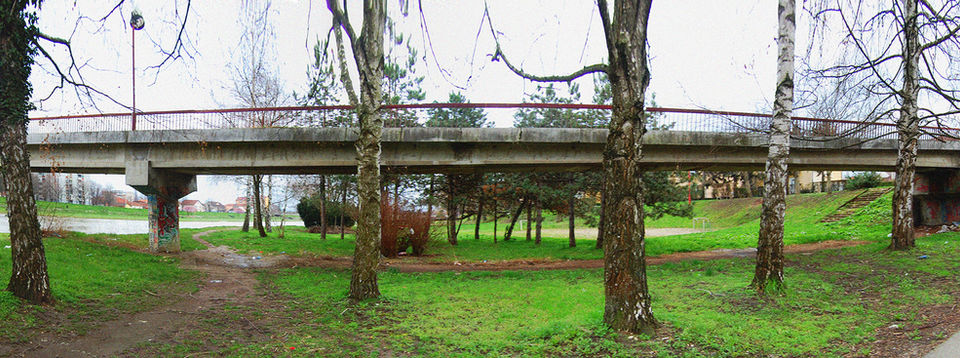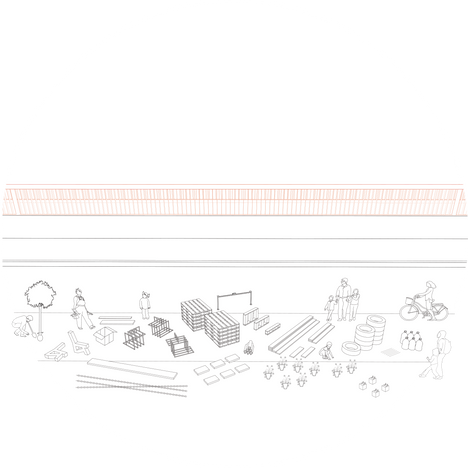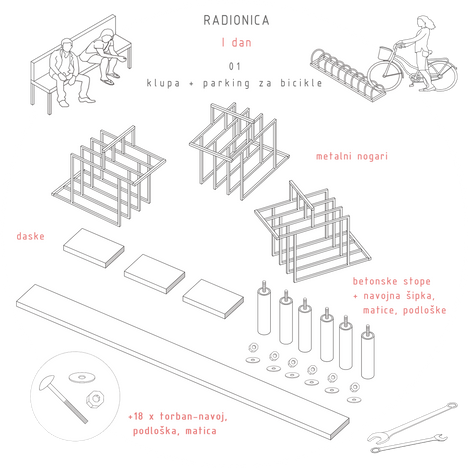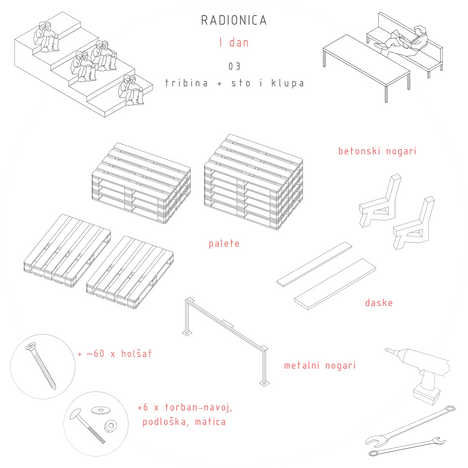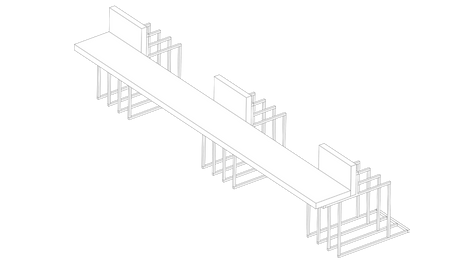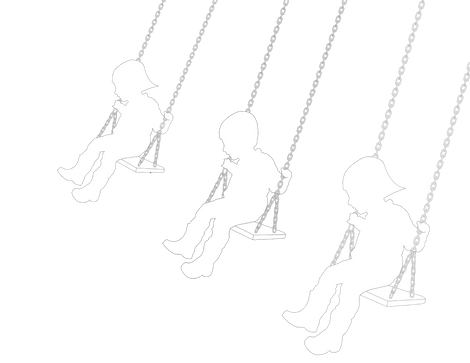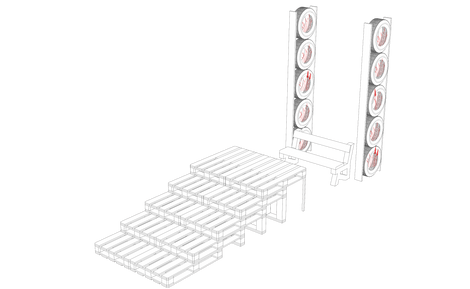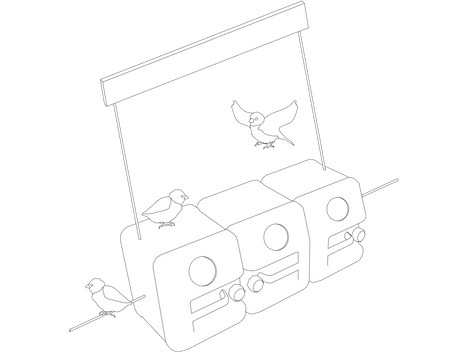


project: O:TVORENO IGRALIŠTE | PLAYGROUND
type: Workshop: architecture + micro-urbanism | Education | Activism
function: Public Space
location: Most Mladosti (Bridge of Youth), Čačak, Serbia
year: June 17 - 19 2016
status: Realised
authors: Stefan Radošević, Luka Višnjić
participants: Children & youth of Čačak, Dina Bralović Shkrabatorre
associates: Jovana Jovanović, Ana Obradović, Lazar Stanojčić, Radoslav Stojić
investor: AΔA (Stefan Radošević, Luka Višnjić)
video: Stefan Radošević, Luka Višnjić, Đorđe Milosavljević, Mihajlo Vitezović









site context:
The abandoned and unused space under and around the pedestrian bridge on the river Zapadna Morava creates a discontinuity of the coastal area in terms of content and connection with existing sports and recreational facilities, on one side, and the pedestrian zone on the other.
The lack of organized space for playing, gathering and dwelling of the youngest fellow citizens in the outdoors is one of the recognized problems and potentials of the riverside.
The solving of spatial-program problem, in terms of new content, aims to improve the quality of life and affects dwelling in an open space (natural environment).
workshop program:
Participants of the educational and practical workshop actively participate in creative work at a specific location in creating their own space of play and dwelling. Through the active action at the cognitive level, this method influences, develops and encourages the awareness of young people about the quality of their own work products and advocacy for the community in order to develop their own environment. The program consists of two parts:
1) Designer (drawing) - Participants explore the potential of a specific public space through their own ideas and suggestions of intervention, using cognitive - interactive sheets, maps, and workbooks that contain the set of tools and existing materials related to the practical part.
2) Practical (constructive) - Participants create a place in the (same) specific space, building on the existing context ("plug-in"), constructing a ephemeral structure from pre-designed element materials and tools, according to the proposed project of the authors (coordinators) of the workshop.
spatial concept:
In architectural terms, the Bridge of Youth is, contextually and conceptually, treated as a polyvalent, vertically and horizontally layered (infra) structure. In addition to its primary function - the pedestrian communication between the two banks of the river, which in this case represents the upper level or the "fifth facade", by intervention, it becomes the carrier and canopy for the spatial elements positioned in its linear projection below, as well as the canvas for the mural. Thus, it communicates both horizontally and vertically (pedestrian zone : riverside : playground : river) through its users.
The installed elements form a unique whole with the bridge, where those under it are placed logically to the usage of surrounding environment, upgrading to those elements of the flora (tree plant) and the fauna (bird feeder among the trees), on the green surface nearby.
In the artistic - aesthetic view, spatial elements are defined by combination of natural - wood in new materials and white paint on recycled, re-coded materials, which, in fact, formally and functionally, "purifies" or "resets" and unifies segments of elements in a new "reading" and new use. The painting of parts of the bridge in white has the same goal, preparing it as a basis for artistic intervention.
Instead of dumps, a playground is created, while discarded materials, instead of waste, become a part of design. The newly established place in the space under the bridge becomes a "portal" between the two riverside zones which it connects.
process chronicle:
"Man is most nearly himself when he achieves the seriousness of a child at play."
- Heraclitus
The idea to open space and create a place with "guerrilla" action, and later with the architecture workshop O:TVORENO IGRALIŠTE (O:PEN PLAYGROUND) for children and young people, proves to be an excellent program concept for the upcoming first DUK Festival (Days of Urban Culture), which supports youth activism and every aspect of creative activity of young people in general, and part of the site where it is maintained offers great potential.
"The Bridge of Youth, as a gift for the Youth, to join the shores and their hearts", is the board inscription on the bridge , which will soon be rejuvenated through play, learning and creation. The idea of the workshop, primarily intended for children and young people, was supported by friends and members of the festival organization, Milorad Obradović, Dragana Živanović and Olgica Terzić, which was an additional reason to pursue intentions.
Motivated, they continue to collect and reform material that will be used by participants for seizing the space on the day of the workshop. Beginning with a bicycle parking bench, through the central motif - the swings, along with the micro-ambience of the vertical garden with another bench, whose concrete structure is found in the dumps, just below the bridge, Luka and Stefan create a vision of the game site. The two go to the village of Stančići, to the estate of Stefan's uncle Radoslav Stojić, with whose help, they start working on design for urban furniture.
When they've gone deeper in the elaboration of the idea, the entire enterprise becomes a real challenge and enjoyment through art and design. The reflection on the program of the workshop itself has become more comprehensive and conceptually more complete. The design was intended to "re-code" discarded used items (metal trolleys, pallets, tires, canisters ...) giving them a new function and a new aesthetics. After rough work, the duo goes from the village into the town, in Luka's yard, where the finalization of the spatial elements takes place.
On the other hand, it comes to the conclusion that the architecture workshop itself should include a drawing (design) part of the program. The approach is to create axonometric and perspective, cognitive - interactive drawing sheets, which aim to motivate participants and to implement their own ideas and vision of game space through the drawings (projects) in the newly established Youth Park.
Due to the constant overwhelming inspiration and the idea of connection of the entire experiment in terms of content, a cognitive interactive - workbook, which connects the drawing and practical part of the program, is created. It contains the intention of the program of workshops, drawings of materials used, proposed elements of furniture and necessary tools, drawing space for sketching and developing ideas.
What is left at the end of the preparatory work is to call the participants, the annunciation of the workshop and to treat the deserted area under the bridge which needs to be cleaned, painted, illuminated and white.
Considering that this type of architecture and micro-urbanism workshop is held for the first time in the environment, such as Čačak, and as part of the program at the DUK festival itself (which has already been divided into murals painting activities, extreme sports of skateboarding and roller skates, as well as music concerts), attracting the attention of potential participants was a serious undertaking. On the one hand, Luka and Stefan, on their own initiative, come in contact with teachers and professors of elementary and secondary schools, through which they reach children and young people. They also print flyers - invitations that they share and scatter around the town. On the other hand, Dragana meets them with Vladimir Gospavić and the Scout squad Vojvoda Stepa, from whom they receive full support and guaranteed participation, and DUK organizes a presentation of workshops at the Cultural Center in Čačak, where Stefan and Luka, through the Intro film, sheets, workbooks , and some of the spatial elements, hold the introductory class.
After successfully conducted introductory class, it is still necessary, in remaining seven days, to clean the dump under the bridge, remove the humus layer, strew the white gravel, whitewash the bridge and prepare for a potential mural and install lamps. Through all-day work, the duo with the team of organizers and volunteers, gathered around the festival, and the invaluable help of the children who dwelled under the bridge, managed to finish the work and prepare the workshop space till evening before the beginning of the festival.
That morning, the van brought the material and school desks from the elementary school "Vuk Karadžić", thanks to the principal Dragan Parezanović, whom Dragana, Luka and Stefan persuaded for a two-day loan. An o:pen classroom among the birch trees is formed, and an o:pen warehouse for tools and materials ready for upcoming mastery under the bridge, is formed.
What happens in this experiment in the next three days can hardly be placed in the textual content of this chronicle, because it is an explosion of energy and a multi-event catalyst. Children who have a strong desire to draw and project, to construct, to dig the ground for basis, to use screwdrivers, to paint, to plant and to get dirty. An involement includes the Scout squad, random passersby, parents with kids, who come thrilled with such an initiative in the town. In coordination of the workshop Luka and Stefan are joined by their friends Jovana Jovanović, Ana Obradović and Lazar Stanojčić. In the context of the environment, the wall and pillar of the bridge are left to the work of Dina Bralović Shkrabatorre, who painted a two-part artistic composition of the siren, over which the playground is lying (sailing). The filmmakers Đorđe Milosavljević Gera and Mihajlo Vitezović come from Belgrade and record the whole event, which with the previous video material, turn into a short experimental documentary about this venture.
The conquest of the space under the bridge lasts for three days, where after each, as an incentive and "reward", one swing, hung on the bridge construction is installed. Thus, the swings, as the biggest sensation, subtly become a leitmotif - a symbol of the O:TVORENO concept, representing a simple carefree element of playing in the function of celebrating youth and the playing itself.
The spiritual and emotional result of this undertaking is immeasurable. The physical result consists of over 100 sheets outlined in ideas about the space of the game, a space under the bridge that has brought life to a new place through the energy of interpersonal unity and creative action, as well as extensive video material, which is passed to all who want to create their own vision of the whole action. Thus, through video and film, the idea of action O:TVORENO IGRALIŠTE (O:PEN PLAYGROUND) continues to live in another medium, as a successful action in the service of creation for everything that grows - birds, plants and a child in a man.
O:TVORENO is in its own duration, and it is left to people and time. It is given to those who will demolish and destroy it, and those who will repair it and rebuild with their own needs and logic. This is nothing more than a picture of an embodied idea in reality, where the elements of Ada openly act in the social and material space, through people familiar polarities. The truth is that dream, thought and energy, from one plane, one triangle of delta, grows into the system of plains, the tetrahedron of the mountain of AΔA...
location coordinates: 43°53'56.7"N 20°20'52.6"E
film: O:TVORENO IGRALIŠTE | O:PEN PLAYGROUND
type: Documentary - experimental
camera: Stefan Radošević, Luka Višnjić, Đorđe Milosavljević, Mihajlo Vitezović
directed & edited by Đorđe Milosavljević, Mihajlo Vitezović, Stefan Radošević,
duration: 6' 22''
year: 2016











